Science History Museum

Entrance

As technology changes, memories of what came before tends to be lost by generations who didn't grow up with them. In the days before the Internet, if you bought something with your credit card in a store, it would be placed on this credit card machine to create a carbon copy of the raised numbers of letters necessary for the store to send it the credit card company.
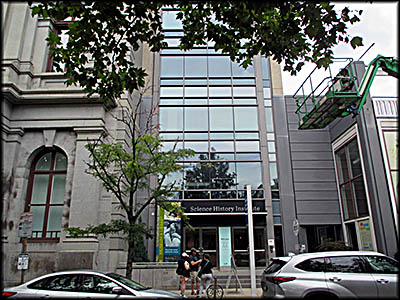

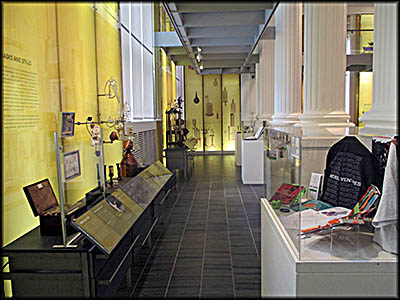
Inside the Museum

This $55 bill was printed by Benjamin Franklin.
Wikimedia Commons
Wikimedia Commons
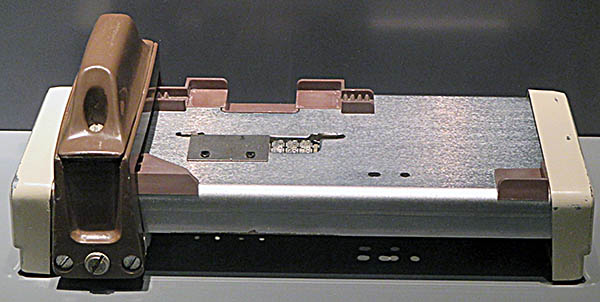
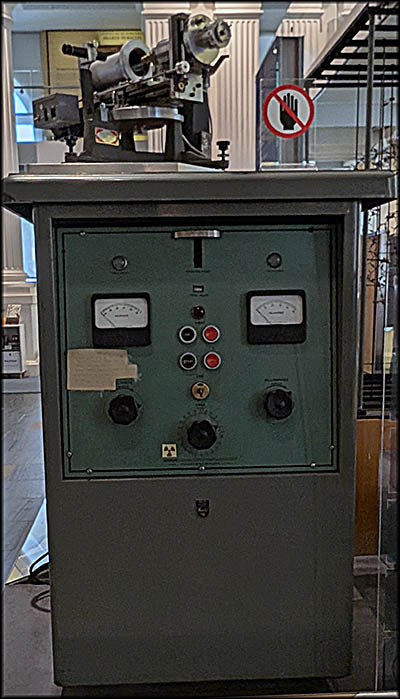
This X-Ray machine used by scientists was used to scan items, not people.

Vacuum Tube

Integrated Circuit

A Book for Alchemists

Lab items to generate heat. Some are less safe than others.
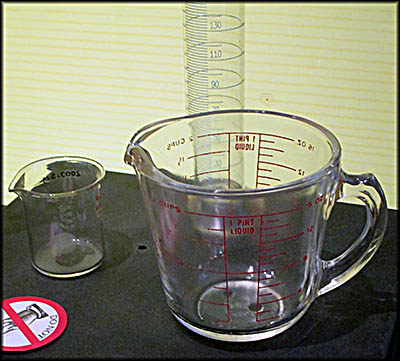
Pyrex glass like here is especially good at not shattering or cracking with rapid temperature or pressure changes.
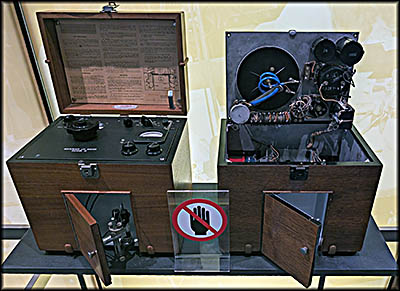
PH Meter Invented by Arnold Beckman

Vacuum Tube-Powered Radio


Transistor Radio
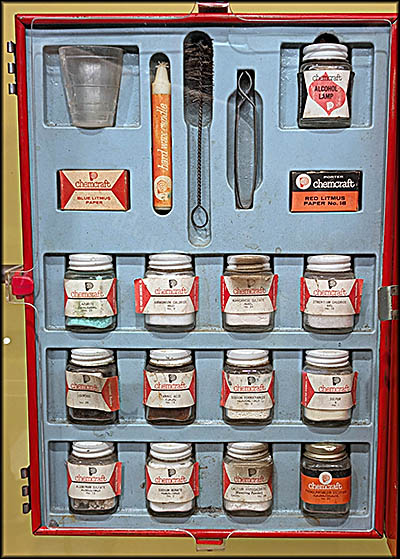


Many of the foods you see here were originally developed for the U.S. military.
Kool-Aid has unnatural colors created by dyes, as do other modern foods. The trouble, some of them weren't safe, such as Red Dye No. 2.
Stills are an important device in a chemistry lab.
This chemistry set was meant for children, but it did have a few dangerous items like the alcohol lamp. The dangerous stuff was banned in 1960.
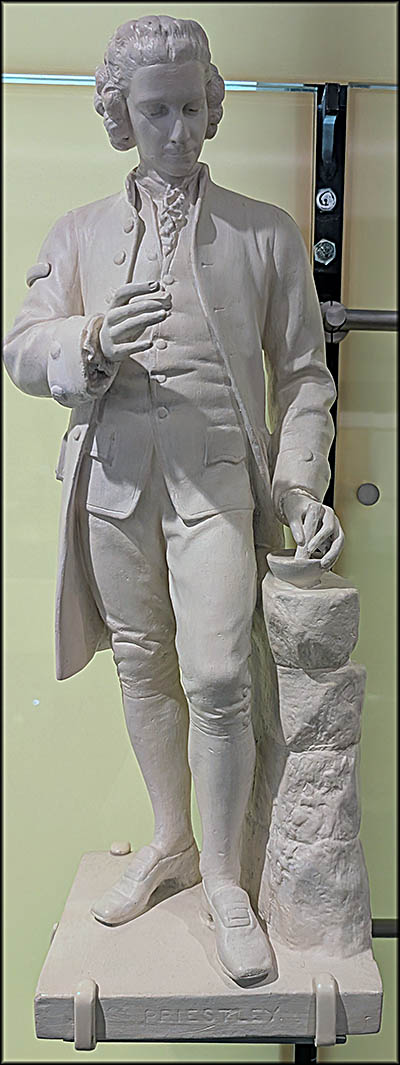

Hot air balloons, which use a bit chemistry to float, but they only go up and down. This illustration shows on idea to control movement.
Joseph Priestly discovered eight gases including oxygen. Another of his many achievements was inventing the timeline.

Cod liver oil has high levels of vitamins A and D, and one of its historic uses was to give it to children to prevent rickets, the malnutrition-cased disease where a child's legs are bowed outward. It is good for other ailments, but much can be toxic.
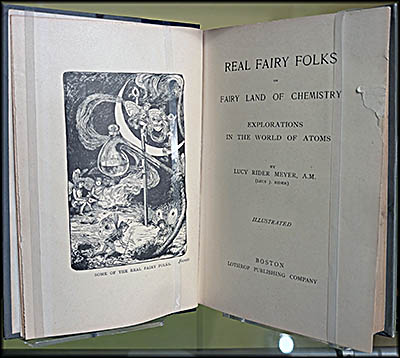
Real Fairy Folks was used to teach children the basic fundamentals of chemistry in an engaging way.
Double click to edit1 While planning for a trip to Philadelphia, I looked for things that I and my traveling companions might like to do. As our visit proceeded, it became increasingly obvious that using the local mass transit system, SEPTA, wasn’t for the feign of heart. We had some extra time one afternoon while in the historic district and decided to stay there rather than visit another place that we could only reach using SEPTA, Uber, or a taxi. By this time we’d walked around here quite a bit, and I recalled seeing the Science History Institute the day before, which I hadn’t known about.
Upon entering, we asked for the price of admission and were told there isn’t any. Free is a rarity for Philadelphia museums. The SHI is well-designed and has a really high ceiling, in part to accommodate the mezzanine that serves as its second floor. It’s filled with all sorts of artifacts from science’s past. Even though its floorspace amounts to just 666 square feet, give yourself and hour and a half to two hours for your visit if you plan to read the majority of information signs.
Different sections have their own theme. One, for example, was about the development of money. Over human history money has taken many forms. The Aztecs used ripened, dried cocoa beans to pay for things. In other parts of the world, exchange was done with barter or salt. As humans began inventing new technologies to meet their needs, someone figured out how to mint coins using metallurgy. The world’ first minted coins came from Lydia, a kingdom in what is now present-day Turkey. The coins were struck in different sizes and weights to denote their value.
The ever-inventive Chinese invented paper in 105 c.e., then starting printing bills on it on in 1189. The Mongols conquered China in 1205. Kublai Khan took the throne in 1260 and under his rulership he replaced all coins with paper money because it weighed less and was thus easier to transport across the vast Mongol Empire. In Colonial America, Benjamin Franklin started printing money with molds of tree leaves in the bills’ image as an anti-counterfeit measure. Today the $100 bill upon which his face can be found has multiple anti-counterfeit measures, and some go beyond the bill itself. When I took a photo of an information sign with Franklin’s engraved face from the $100 bill in the background and tried to open it in Photoshop, it wouldn’t let me, claiming it couldn’t open images of money despite the fact no actually bills were on the sign.
Upon entering, we asked for the price of admission and were told there isn’t any. Free is a rarity for Philadelphia museums. The SHI is well-designed and has a really high ceiling, in part to accommodate the mezzanine that serves as its second floor. It’s filled with all sorts of artifacts from science’s past. Even though its floorspace amounts to just 666 square feet, give yourself and hour and a half to two hours for your visit if you plan to read the majority of information signs.
Different sections have their own theme. One, for example, was about the development of money. Over human history money has taken many forms. The Aztecs used ripened, dried cocoa beans to pay for things. In other parts of the world, exchange was done with barter or salt. As humans began inventing new technologies to meet their needs, someone figured out how to mint coins using metallurgy. The world’ first minted coins came from Lydia, a kingdom in what is now present-day Turkey. The coins were struck in different sizes and weights to denote their value.
The ever-inventive Chinese invented paper in 105 c.e., then starting printing bills on it on in 1189. The Mongols conquered China in 1205. Kublai Khan took the throne in 1260 and under his rulership he replaced all coins with paper money because it weighed less and was thus easier to transport across the vast Mongol Empire. In Colonial America, Benjamin Franklin started printing money with molds of tree leaves in the bills’ image as an anti-counterfeit measure. Today the $100 bill upon which his face can be found has multiple anti-counterfeit measures, and some go beyond the bill itself. When I took a photo of an information sign with Franklin’s engraved face from the $100 bill in the background and tried to open it in Photoshop, it wouldn’t let me, claiming it couldn’t open images of money despite the fact no actually bills were on the sign.
William Crookes discovered the cathode-ray in 1879 using a Maltese Cross-shaped glass. We now call these rays electrons from which comes the word “electronics.” Building on this experiment, Wilhelm Rüntegen sent an electric current through a cathode-ray tube in 1895 and found the resulting radiation penetrated objects, allowing him to take photographs of them, such as the bones of a hand. He called these x-rays. Scientists of a later age used x-rays for crystallography, the technique of crystalizing molecules, then photographing them.
GE established the General Electric Research Lab in 1900 to make better lightbulbs, its biggest money maker at the time. This led to the development of the vacuum tube, which can be used as amplifiers or switches. They were especially beneficial in radios. Although vacuum tubes were obsolete by the mid-1970s, you could still find testing machines in for them in stores . Believe it or not, it was possible to miniaturize vacuum tubes, and early hearing aids contained them.
But miniaturized tubes had its limits, and in the late 1940s, Bell Labs created an amplifier out of a sliver of germanium and wires. Bell executives were skeptical that this little device did as advertised, so it was hooked up to an oscillator and sure enough it did. Bell Labs had invented the transistor. Early ones, made by hand, didn’t work especially well, but soon enough a way to mass produce reliable ones was found. The first transistor radio came out in 1954, and manufacturers couldn’t make enough of them to meet demand.
GE established the General Electric Research Lab in 1900 to make better lightbulbs, its biggest money maker at the time. This led to the development of the vacuum tube, which can be used as amplifiers or switches. They were especially beneficial in radios. Although vacuum tubes were obsolete by the mid-1970s, you could still find testing machines in for them in stores . Believe it or not, it was possible to miniaturize vacuum tubes, and early hearing aids contained them.
But miniaturized tubes had its limits, and in the late 1940s, Bell Labs created an amplifier out of a sliver of germanium and wires. Bell executives were skeptical that this little device did as advertised, so it was hooked up to an oscillator and sure enough it did. Bell Labs had invented the transistor. Early ones, made by hand, didn’t work especially well, but soon enough a way to mass produce reliable ones was found. The first transistor radio came out in 1954, and manufacturers couldn’t make enough of them to meet demand.
Next came the integrated circuit, the technology microprocessors are based on. NASA needed integrated circuits to power its Apollo program’s guidance computers, and the Air Force wanted them for guiding nuclear missiles. The earliest type of memory used for early digital computers consisted of three wires hand woven by mostly women as they looked through microscopes.
A museum information sign explains how these worked: “Data was written by sending an electrical pulse down the horizontal wire and vertical wire that represented each core’s ‘address.’ Added together, these pulses reversed the polarity of the magnet, recording a 0 or a 1. The third wire, threaded through every core on the card, read and erased the memory.”
You need rare earth minerals to make to make integrated circuits and microprocesses. The trouble is, mining them isn’t easy. Getting to and separating them out from other bits of earth often produces toxic waste, some of it radioactive, making those around the mines sick. The Chinese government decided human illness and deaths were acceptable, so it dominates rare earth extraction. It does most of it around the village of Bayan Ovo in Inner Mongolia near the Chinese-Mongolian border, and in Ganzhou Province far to the south. This is the price we pay for smart phones, electric vehicles, and even washing machines.
A museum information sign explains how these worked: “Data was written by sending an electrical pulse down the horizontal wire and vertical wire that represented each core’s ‘address.’ Added together, these pulses reversed the polarity of the magnet, recording a 0 or a 1. The third wire, threaded through every core on the card, read and erased the memory.”
You need rare earth minerals to make to make integrated circuits and microprocesses. The trouble is, mining them isn’t easy. Getting to and separating them out from other bits of earth often produces toxic waste, some of it radioactive, making those around the mines sick. The Chinese government decided human illness and deaths were acceptable, so it dominates rare earth extraction. It does most of it around the village of Bayan Ovo in Inner Mongolia near the Chinese-Mongolian border, and in Ganzhou Province far to the south. This is the price we pay for smart phones, electric vehicles, and even washing machines.
The modern science of chemistry has its origins in alchemy, which traces its start to Egyptian artisans operating in the 4th century b.c.e., whose ideas were later prompted and expanded by Islamic scholars. This knowledge made its way into Europe in the 12th century and became what we know today as alchemy. It’s hard to say how many alchemists aimed to transform lead into gold or create the so-called Philosopher’s stone. Most considered themselves “natural philosophers”—early scientists who investigated how nature worked. Alchemists researched practical things like determining the hardness of metals, creating dyes and pigments, figuring out the density of minerals, and discovering which plants could be used as medicines. They recorded their discoveries in books and set up laboratories to perform experiments.
Alchemists even practiced in North America. George Starkey began life in Bermuda in 1628. Educated at Harvard, he made a living as a physician in Boston. He used alchemy to develop new medicines but found the equipment he needed for his research, especially glass, below par or not available. In 1650 at the age of twenty-two, he and his wife moved to England where he could find better apparatuses. He also joined the “Invisible College” group of natural philosophers started by Samuel Hartlib. Here Starkey met and influenced Robert Boyle, who’s considered the founder of modern chemistry. Starkey died in the London’s Great Plague in 1665.
As chemistry became a scientific discipline, chemists at universities starting grouped alchemists in with occultists and magicians despite the fact much of what was taught to them had been discovered by alchemists. Alchemists and later chemists shared the same tools for experimentation, such as flasks, stills, and cupels. All these items, whether made of glass or bone ash, were designed to deal with heat. Want to make perfume? Distill an essential oil, feed the resulting vapor into another container where it condenses into a purified form.
Alchemists even practiced in North America. George Starkey began life in Bermuda in 1628. Educated at Harvard, he made a living as a physician in Boston. He used alchemy to develop new medicines but found the equipment he needed for his research, especially glass, below par or not available. In 1650 at the age of twenty-two, he and his wife moved to England where he could find better apparatuses. He also joined the “Invisible College” group of natural philosophers started by Samuel Hartlib. Here Starkey met and influenced Robert Boyle, who’s considered the founder of modern chemistry. Starkey died in the London’s Great Plague in 1665.
As chemistry became a scientific discipline, chemists at universities starting grouped alchemists in with occultists and magicians despite the fact much of what was taught to them had been discovered by alchemists. Alchemists and later chemists shared the same tools for experimentation, such as flasks, stills, and cupels. All these items, whether made of glass or bone ash, were designed to deal with heat. Want to make perfume? Distill an essential oil, feed the resulting vapor into another container where it condenses into a purified form.
Glass containers in particular had a habit of cracking when the temperature or pressure changed too quickly, ruining many experiments. Chemist Otto Schott discovered in 1882 that adding boron trioxide to glass increased its resistance to this downside. Using the same technique, Corning Glass Works released Nonex (“non-expanded”) glass in 1908 for use as railroad signal lenses. In 1913, Bessie Cook Littleton got hold of some of this glass from her husband, who was a physicist at Corning, and used it to cook food. It worked so well, Corning researchers developed a glass pie dish made of it, the inspiration for the commercial name Pyrex.
The aforementioned rise of electronics proved beneficial to chemists. It allowed, as an example, Arnold Beckman to more efficiently measure PH levels in California citrus orchards. Existing onsite machines were fragile, frustrating him. To remedy this, he created the first electronic PH meter in 1934 using vacuum tubes. It wasn’t just more robust that what had come before it, it also sped up the process of testing.
The aforementioned rise of electronics proved beneficial to chemists. It allowed, as an example, Arnold Beckman to more efficiently measure PH levels in California citrus orchards. Existing onsite machines were fragile, frustrating him. To remedy this, he created the first electronic PH meter in 1934 using vacuum tubes. It wasn’t just more robust that what had come before it, it also sped up the process of testing.
Chemistry and food are intricately connected in many ways. During our visit, there was a temporary exhibition called "Lunchtime: The History of Science on the School Food Tray,” and it ties right in with the present course of this travel log. Cooking food is chemistry, so it ought not be a surprise that chemists in the eighteenth century started digging into many aspects of what we humans eat. In 1821, German chemist Frerich Christian Accum published Culinary Chemistry: Exhibiting the Science Principles of Cookery. He argued that better cooking and preserving processes would make food tastier and safer.
He wasn’t wrong. Aside from Clarence Birdsey frozen fish operation that was inspired by a technique used by the Inuit, freezing food on a commercial scale in the 1920s and 1930s had little success because its taste and smell weren’t that good. In 1949, the USDA started examining foods that became unpalatable after freezing. They did this using a gas chromatographer, which, says an information sign, “separates and identifies the parts of a mixture,” allowing researchers to figure out for how long and at what temperature does a given food need to be frozen. As a result, frozen food sales jumped “from $500 million in to more than $6 billion by 1966.”
This certainly wasn’t the first scientific analysis of food done in the United States. In 1910, Louise Stevens Bryant observed that children in New York City’s schools often bought their lunches from carts and stores, so she bought samples and sent them to Columbia’s Teachers College to be analyzed. It wasn’t nutritious. Journalist John Spargo studied what children ate in 1907 and found they often made poor choices, such as candy, ice cream, and even cigarettes. Worse, most were too poor to eat anything at all. This early work created the groundwork for the introduced nutritious school lunches.
He wasn’t wrong. Aside from Clarence Birdsey frozen fish operation that was inspired by a technique used by the Inuit, freezing food on a commercial scale in the 1920s and 1930s had little success because its taste and smell weren’t that good. In 1949, the USDA started examining foods that became unpalatable after freezing. They did this using a gas chromatographer, which, says an information sign, “separates and identifies the parts of a mixture,” allowing researchers to figure out for how long and at what temperature does a given food need to be frozen. As a result, frozen food sales jumped “from $500 million in to more than $6 billion by 1966.”
This certainly wasn’t the first scientific analysis of food done in the United States. In 1910, Louise Stevens Bryant observed that children in New York City’s schools often bought their lunches from carts and stores, so she bought samples and sent them to Columbia’s Teachers College to be analyzed. It wasn’t nutritious. Journalist John Spargo studied what children ate in 1907 and found they often made poor choices, such as candy, ice cream, and even cigarettes. Worse, most were too poor to eat anything at all. This early work created the groundwork for the introduced nutritious school lunches.
One of the displays in the “Lunchtime” exhibit contained a variety of modern junk and low-cost foods. I figured it would go on the say something on the order of, “Is this what you want children to eat at school?’ It had a much different purpose. It told the origin of these foods and what prompted their creation.
Here’s a sampling: M&M’s were designed to be a chocolate treat in military field rations that didn’t melt. They weren’t sold to the civilian market until after the end of World War II. The cheese powder used in Cheetos was part of a military food dehydration program for that same war, as was SPAM. On long Naval flights, heated up frozen dinners were served. Modern breakfast bars are a derivative of the U.S. military’s effort to create an energy bar for soldiers on the move.🕜
Here’s a sampling: M&M’s were designed to be a chocolate treat in military field rations that didn’t melt. They weren’t sold to the civilian market until after the end of World War II. The cheese powder used in Cheetos was part of a military food dehydration program for that same war, as was SPAM. On long Naval flights, heated up frozen dinners were served. Modern breakfast bars are a derivative of the U.S. military’s effort to create an energy bar for soldiers on the move.🕜